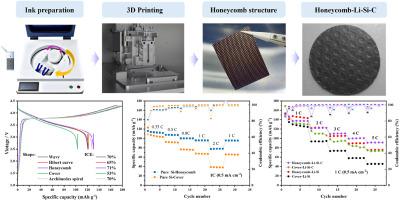3D-printed honeycomb lithium-silicon alloy anodes for stabilized interface in sulfide all-solid-state batteries
IF 17
1区 工程技术
Q1 ENERGY & FUELS
引用次数: 0
Abstract
Solid-state batteries have emerged as a crucial development direction for next-generation energy storage technologies, owing to their high energy density, long cycle life, and excellent safety. However, the most challenging issue of interfacial contact/degradation in solid-state batteries remains unsolved. Herein, a novel Si-C interlocking honeycomb electrode is designed/realized via 3D printing technology. Achieves 98.9 % capacity retention over 2100 cycles at 1C. The honeycomb pore walls form a mortise-tenon structure with the electrolyte to maintain good interfacial contact, while the hard carbon layer isolates the electrolyte from the lithium-silicon interface, thereby stabilizing the growth of the solid electrolyte interphase (SEI) and achieving stress-electrochemical coupling regulation. Moreover, as the honeycomb channels form an interpenetrating structure with the solid electrolyte, a three-dimensional ion transport network is established, shortening the lithium-ion diffusion path, enhancing the interfacial contact between the electrode and solid electrolyte, reducing the risk of lithium dendrite formation, and improving the rate performance of all-solid-state batteries. This approach leverages structural design to enhance material performance, for the first time enabling the compatibility of 3D-printed structured silicon-based anodes with sulfide-based all-solid-state systems, thus providing a scalable solution for next-generation high-energy-density batteries.

用于硫化物全固态电池稳定界面的3d打印蜂窝锂硅合金阳极
固态电池具有能量密度高、循环寿命长、安全性好等优点,已成为下一代储能技术的重要发展方向。然而,固态电池中最具挑战性的界面接触/降解问题仍未得到解决。本文采用3D打印技术设计/实现了一种新型硅碳联锁蜂窝电极。达到98.9%的容量保持超过2100循环在1C。蜂窝孔壁与电解质形成榫卯结构,保持良好的界面接触,而硬碳层将电解质与锂硅界面隔离,从而稳定固体电解质界面相(SEI)的生长,实现应力-电化学耦合调节。此外,由于蜂窝通道与固体电解质形成互穿结构,建立了三维离子输运网络,缩短了锂离子扩散路径,增强了电极与固体电解质的界面接触,降低了锂枝晶形成的风险,提高了全固态电池的速率性能。这种方法利用结构设计来提高材料性能,首次实现了3d打印结构硅基阳极与硫化物基全固态系统的兼容性,从而为下一代高能量密度电池提供了可扩展的解决方案。
本文章由计算机程序翻译,如有差异,请以英文原文为准。
求助全文
约1分钟内获得全文
求助全文
来源期刊

Etransportation
Engineering-Automotive Engineering
CiteScore
19.80
自引率
12.60%
发文量
57
审稿时长
39 days
期刊介绍:
eTransportation is a scholarly journal that aims to advance knowledge in the field of electric transportation. It focuses on all modes of transportation that utilize electricity as their primary source of energy, including electric vehicles, trains, ships, and aircraft. The journal covers all stages of research, development, and testing of new technologies, systems, and devices related to electrical transportation.
The journal welcomes the use of simulation and analysis tools at the system, transport, or device level. Its primary emphasis is on the study of the electrical and electronic aspects of transportation systems. However, it also considers research on mechanical parts or subsystems of vehicles if there is a clear interaction with electrical or electronic equipment.
Please note that this journal excludes other aspects such as sociological, political, regulatory, or environmental factors from its scope.
 求助内容:
求助内容: 应助结果提醒方式:
应助结果提醒方式:


